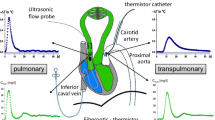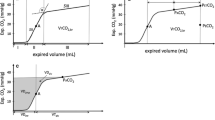Abstract
The depressant effects of continuous positive-pressure ventilation (CPPV) on circulatory and renal functions, and their reversal by dopamine (5 μg/kg/min), dobutamine (7.5 μg/kg/min), or a combination of the two drugs (dopamine 2.5 and dobutamine 5 μg/kg/min) were studied in 10 patients with acute respiratory distress syndrome (ARDS) requiring treatment with positive end-expiratory pressure (PEEP). In comparison with a control period of intermittent positive-pressure ventilation (IPPV), CPPV increased arterial oxygen tension (PaO2) by 11%, but decreased the cardiac index (CI) by 21% and systemic oxygen transport (TO 2) by 14%. The additional administration of catecholamines resulted in an increase both in CI — by 38% (dopamine), 33% (dobutamine), and 47% (combination) — and in TO 2 —by 34% (dopamine), 28% (dobutamine) and 46% (combination). The observed changes in PaO2 were negligible. The changeover from IPPV to CPPV resulted in a marked decrease in urinary output (42%), sodium excretion (52%), and in creatinine clearance (36%). Under dopamine or the combination of dopamine and dobutamine there was a two- to threefold improvement in these parameters as compared with the CPPV figures, while under dobutamine alone, the increases were virtually of the same order as the increase in CI. It may be concluded that both dopamine and dobutamine are suitable for correcting impaired circulatory and renal functions induced by CPPV. Their beneficial effects on circulatory and respiratory parameters are virtually identical. In the presence of renal failure, the use of dopamine or a combination of the two drugs is recommended.
Similar content being viewed by others
References
Augustin HJ, Bischoff K, Engels T (1979) Der Einfluß von Dopamin auf die Nierenfunktion während kontinuierlicher Überdruckbeatmung (PEEP). Anaesthesist 28:159
Augustin HJ, Melderis H, Pantelen H, v Wichert P (1979) Hämodynamische und renovaskuläre Wirkungen von Dopamin und Dobutamin. Intensivmedizin 16:195
Baratz RA, Philbin DM, Patterson RW (1971) Plasma antidiuretic hormone and urinary output during continuous positive-pressure breathing in dogs. Anesthesiology 34:510
Benzer H, Haider W, Kundi M, Laczkovics A, Todt W (1977) Die Kombination von kontinuierlicher Überdruckbeatmung (PEEP) und Dopamin beim postkardiochirurgischen Patienten. Herz 2:465
Berryhill RE, Benumof JL (1979) PEEP — induced discrepancy between pulmonary arterial wedge pressure and left atrial pressure: The effects of controlled vs. spontaneous ventilation and compliant vs. noncompliant lungs in the dog. Anesthesiology 51:303
Brown DR, Bazaral MG, Nath PH, Delaney DJ (1981) Canine left ventricular volume response to mechanical ventilation with PEEP. Anesthesiology 54:409
Chamberlain JH, Pepper JR, Yates AK (1980) Dobutamine, isoprenaline and dopamine in patients after open heart surgery. Intensive Care Med 7:5
Dantzker DR, Lynch JP, Weg JG (1980) Depression of cardiac output is a mechanism of shunt reduction in the therapy of acute respiratory failure. Chest 77:636
Deepika K, Majerus TC, Chodoff P (1981) Hemodynamic effects of dobutamine in critically ill patients on PEEP. Crit Care Med 9:179 (Abstract)
Downs JB, Douglas ME (1980) Assessment of cardiac filling pressure during continuous positive-pressure ventilation. Crit Care Med 8:285
Fewell JE, Abendschein DR, Carlson CJ, Murray JF, Rapaport E (1980) Continuous positive-pressure ventilation decreases right and left ventricular end-diastolic volumes in the dog. Circ Res 46:125
Hall SV, Johnson EE, Hedley-Whyte J (1974) Renal hemodynamics and function with continuous positive-pressure ventilation in dogs. Anesthesiology 41:452
Hedley-Whyte J, Burgess GE, Feeley TW, Miller MG (1976) Applied physiology of respiratory care. Little, Brown and Company, Boston
Hemmer M, Suter PM (1979) Treatment of cardiac and renal effects of PEEP with dopamine in patients with acute respiratory failure. Anesthesiology 50:399
Hess W, Brückner JB, v Faber du Faur J, Schmidt D, Tarnow J (1979) Hämodynamische Wirkungen von Dobutamin und Dopamin bei Patienten mit koronarer Herzkrankheit. Anaesthesist 28:316
Hilberman M, Maseda J, Spencer RJ, Derby GC, Myers BD, Stinson EB (1980) The renal effects of dopamine and dobutamine. Anesthesiology 53:S119 (Abstract)
Hilberman M, Maseda J, Spencer RJ, Derby GC, Stinson EB (1980) The hemodynamic effects of dopamine and dobutamine. Anesthesiology 53:S121 (Abstract)
Holloway GA, Frederickson EL (1974) Dobutamine, a new beta agonist. Anesth Analg 53:616
Kumar A, Falke KJ, Geffin B, Aldredge CF, Laver MB, Lowenstein E, Pontoppidan H (1970) Continuous positivepressure ventilation in acute respiratory failure. Effects on hemodynamics and lung funtion. N Engl J Med 283:1430
Leier CV, Heban PT, Huss P, Bush CA, Lewis RP (1978) Comparative systemic and regional hemodynamic effects of dopamine and dobutamine in patients with cardiomyopathic heart failure. Circulation 58:466
Lemaire F, Regnier B, Simoneau G, Harf A (1980) Positive end-expiratory pressure (PEEP) ventilation suppresses the increase of shunting caused by dopamine infusion. Anesthesiology 52:376
Liebman PR, Patten MT, Manny J, Shepro D, Hechtman HB (1978) The mechanism of depressed cardiac output on positive end-expiratory pressure (PEEP). Surgery 83:534
Loeb HS, Bredakis J, Gunnar RM (1977) Superiority of dobutamine over dopamine for augmentation of cardiac output in patients with chronic low output cardiac failure. Circulation 55:375
Lutch JS, Murray JF (1972) Continuous positive-pressure ventilation: Effects on systemic oxygen transport and tissure oxygenation. Ann Intern Med 76:193
Marquez JM, Douglas ME, Downs JB, Wu WH, Mantini EL, Kuck EJ, Calderwood HW (1979) Renal function and cardiovascular responses during positive airway pressure. Anesthesiology 50:393
Qvist J, Pontoppidan H, Wilson RS, Lowenstein E, Laver MB (1975) Hemodynamic responses to mechanical ventilation with PEEP: The effect of hypervolemia. Anesthesiology 42:45
Regnier G, Safran D, Carlet J, Teisseire B (1979) Comparative haemodynamic effects of dopamine and dobutamine in septic shock. Intensive Care Med 5:115
Robie N, Goldberg J (1975) Comparative systemic and regional effects of dopamine and dobutamine. Am Heart J 90:340
Suter PM, Fairley HB, Isenberg MD (1975) Optimum end-expiratory airway pressure in patients with acute pulmonary failure. N Engl J Med 292:284
Trichet B, Falke K, Togut A, Laver MB (1975) The effect of pre-existing pulmonary vascular disease on the respone to mechanical ventilation with PEEP following open-heart surgery. Anesthesiology 42:56
Wendt M, Paravicini D, Lawin P, Götz E, Jeruschewski KH (1980) Dobutamin und Kompensation des Herzzeitvolumenabfalls nach PEEP-Beatmung. In: Bleifeld W, Gattiker R, Schaper W, Brade W (eds) Internationales Dobutamin-Symposion. Verhandlungsberichte München 19.–20. 3. 1979. Urban & Schwarzenberg, Munich Vienna Baltimore, p 32
Wirtzfeld A, Klein G, Delius W. Himmler C, Folger G, Davidson J (1978) Dopamin und Dobutamin in der Behandlung der schweren Herzinsuffizienz. Dtsch Med Wochenschr 103:1915
Author information
Authors and Affiliations
Rights and permissions
About this article
Cite this article
Brandl, M., Pasch, T., Kamp, H.D. et al. Comparison of the effects of dopamine and dobutamine during continuous positive-pressure ventilation. Intensive Care Med 9, 61–67 (1983). https://doi.org/10.1007/BF01699258
Accepted:
Issue Date:
DOI: https://doi.org/10.1007/BF01699258




